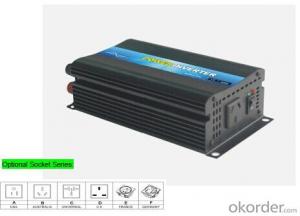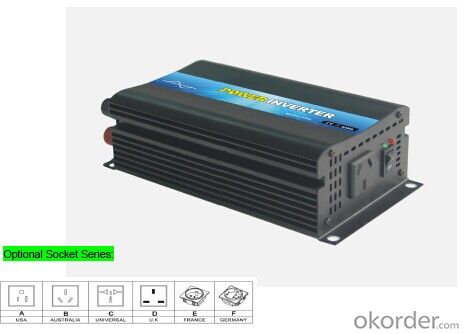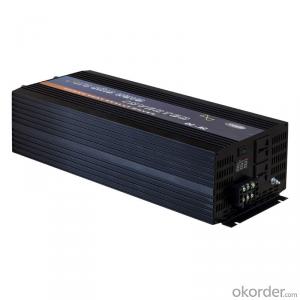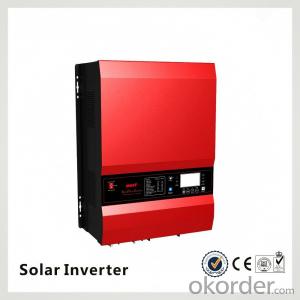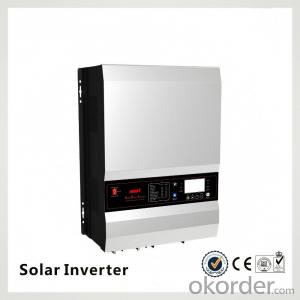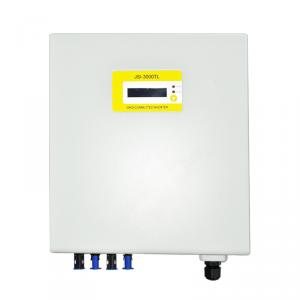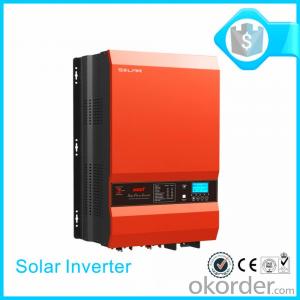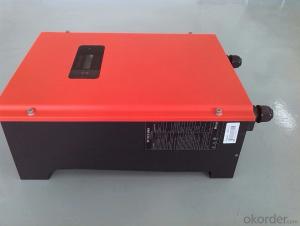Opti Solar Inverter 6000W Off-Grid Solar Inverter
- Loading Port:
- China Main Port
- Payment Terms:
- TT OR LC
- Min Order Qty:
- -
- Supply Capability:
- -
OKorder Service Pledge
OKorder Financial Service
You Might Also Like
Features
Pure sine wave output (THD<3%)
Power ON-OFF switch
Input voltage range:-20% ~ +30%
Output voltage regulation:±10%
Thermo control cooling fan
Two-color indicators display power and fault status
Protections:short circuit, overload, over temperature,
Low battery voltage, over battery voltage, lack-voltage alarm.
Topology: Pull-push
Approvals: CE mark / EMC / LVD/ RoHS
1 year warranty
(Remarks: Customizable input voltage such as 36v, 72v, 96v,110v;output voltage such as 120v, 130v, 200v,240v, etc; )
Order model No | P300w-12A | P3000w-24A | P300w-48A | P300w-12B | P3000w-24B | P300W-48B | ||||||
Output | AC voltage | 110V±10% | 220V±10% | |||||||||
Rated power | 6000W | 6000W | ||||||||||
Peak power | 12000W | 12000W | ||||||||||
Waveform (THD) | Pure sine wave (<3%) | Pure sine wave (<3%) | ||||||||||
Frequency | 60Hz ±0.3% or 50Hz ±0.3% | |||||||||||
Input | NO load current draw | <2.7A | <1.95A | <1.6A | <2.7A | <1.95A | <1.6A | |||||
DC voltage | 12V | 24V | 48V | 12V | 24V | 48V | ||||||
DC Voltage range | 9.5~16V | 19~32V | 38~63V | 9.5~16V | 19~32V | 38~63V | ||||||
Efficiency | > 8 6 % | > 8 8 % | > 90% | > 8 6 % | > 8 8 % | > 9 0 % | ||||||
DC connector | Cables With Clips or Car Adaptor | Cables With Clips or Car Adaptor | ||||||||||
Protection | DCLow voltage alarm | 10.3~10.6V | 20.6V ~21.2V | 41.2V~42.4V | 10.3~10.6V | 20.6V ~21.2V | 41.2V~42.4V | |||||
DC Low voltage shut down | 9.4~9.6V | 18.8~19.2V | 37.6~38.4V | 9.4~9.6V | 18.8~19.2V | 37.6~38.4V | ||||||
Over load | Shut Off Output | Shut Off Output | ||||||||||
DC Over voltage shut down | 15.8~16.2V | 30~32V | 60~63V | 15.8~16.2V | 30~32V | 60~63V | ||||||
Over thermal | Shut Off Output Automatically | Shut Off Output Automatically | ||||||||||
Fuses | Short Circuit | Short Circuit | ||||||||||
Environment | Working temperature | -10°c ~ +50°c | -10°c ~ +50°c | |||||||||
Working humidity | 10%~90%RH | 10%~90%RH | ||||||||||
Storage temperature | -20°c ~ +50°c | -20°c ~ +50°c | ||||||||||
Work altitude | ≤1000m | |||||||||||
Package | Machine Size(mm) | 545*199*146 | 545*199*146 | |||||||||
Packing Size(mm) | 620*270*215 | 620*270*215 | ||||||||||
Net Weight | 12.1kg/unit | 12.1kg/unit | ||||||||||
Gross Weight | 14.7kg/unit | 14.7kg/unit | ||||||||||
Packing Mode | Carton | Carton | ||||||||||
Other | Star | Soft Star | Soft Start | |||||||||
Cooling Ways | Cooling Fan | Cooling Fan | ||||||||||
- Q: What is the role of a solar inverter in a solar-powered water purification system?
- The role of a solar inverter in a solar-powered water purification system is to convert the direct current (DC) electricity generated by the solar panels into alternating current (AC) electricity, which is then used to power the water purification system. The solar inverter ensures that the electricity produced by the solar panels is compatible with the electrical requirements of the water purification system, allowing it to function efficiently.
- Q: Can a solar inverter be used in grid-tied systems?
- Yes, a solar inverter can be used in grid-tied systems. In fact, it is a crucial component of such systems as it converts the DC power generated by solar panels into AC power that can be fed into the electrical grid.
- Q: Can a solar inverter be used with a string inverter system?
- No, a solar inverter cannot be directly used with a string inverter system. A solar inverter converts the direct current (DC) generated by the solar panels into usable alternating current (AC) electricity. On the other hand, a string inverter manages the output of multiple solar panels connected in series, converting the DC power from the panels to AC power for the grid. These two types of inverters serve different functions and are not compatible with each other.
- Q: How does a solar inverter handle fluctuations in solar panel output?
- A solar inverter handles fluctuations in solar panel output by continuously monitoring the voltage and current from the panels. It adjusts the input parameters to maintain a stable output power, compensating for variations in sunlight intensity, temperature changes, and other environmental factors. This ensures a consistent and reliable supply of electricity from the solar panels to the connected electrical load or the grid.
- Q: How do you calculate the payback period for a solar inverter?
- To calculate the payback period for a solar inverter, you need to divide the initial cost of the inverter by the annual savings it generates. The payback period is the amount of time it takes for the cumulative savings to equal the initial cost.
- Q: What is the typical size and weight of a solar inverter?
- The typical size and weight of a solar inverter can vary depending on its power capacity. Generally, residential solar inverters range in size from around 30 x 50 x 20 cm (12 x 20 x 8 inches) to 60 x 60 x 30 cm (24 x 24 x 12 inches) and weigh between 10 kg (22 lbs) to 25 kg (55 lbs). Commercial or utility-scale inverters, on the other hand, can be much larger and heavier, weighing several hundred kilograms (or even tons) and occupying larger spaces.
- Q: What is the maximum AC output current that a solar inverter can provide?
- The maximum AC output current that a solar inverter can provide depends on the specific model and capacity of the inverter. In general, it is determined by factors such as the maximum power rating and efficiency of the inverter, as well as the size and configuration of the solar photovoltaic (PV) system it is connected to.
- Q: Can a solar inverter be used in systems with different module types?
- Yes, a solar inverter can be used in systems with different module types. Solar inverters are designed to convert the DC power generated by solar panels into usable AC power for homes or businesses. They typically have a wide input voltage range and are compatible with various module types, including monocrystalline, polycrystalline, and thin-film panels. However, it is essential to ensure that the inverter's specifications are compatible with the specific module types being used to optimize efficiency and performance.
- Q: Can a solar inverter be used with a solar-powered cooling system?
- Yes, a solar inverter can be used with a solar-powered cooling system. The solar inverter converts the direct current (DC) generated by the solar panels into alternating current (AC) that can be used to power various electrical devices, including the cooling system. This allows for the efficient use of solar energy to run the cooling system, reducing reliance on grid electricity and promoting sustainability.
- Q: What are the advantages of using a transformerless solar inverter?
- One advantage of using a transformerless solar inverter is its higher efficiency. By eliminating the need for a bulky and heavy transformer, the inverter can convert the DC power from the solar panels to AC power more efficiently. This results in less energy loss during the conversion process, leading to higher overall system efficiency and increased energy generation. Additionally, transformerless inverters tend to be smaller and lighter, making them easier to install and maintain.
Send your message to us
Opti Solar Inverter 6000W Off-Grid Solar Inverter
- Loading Port:
- China Main Port
- Payment Terms:
- TT OR LC
- Min Order Qty:
- -
- Supply Capability:
- -
OKorder Service Pledge
OKorder Financial Service
Similar products
Hot products
Hot Searches
Related keywords
